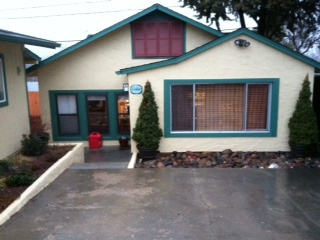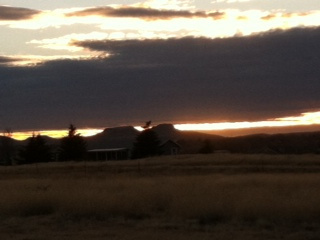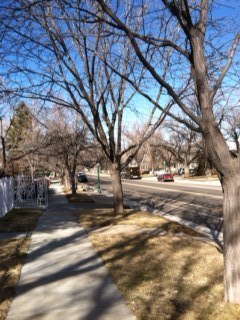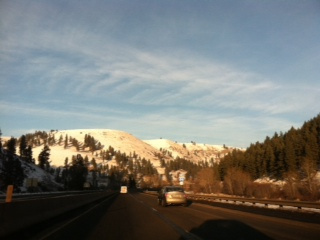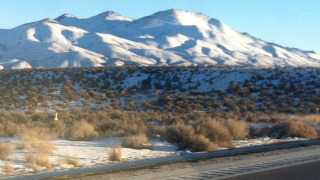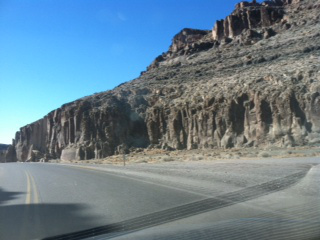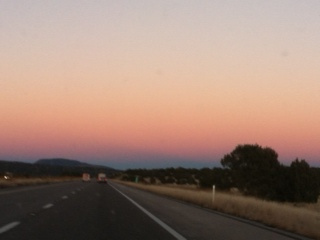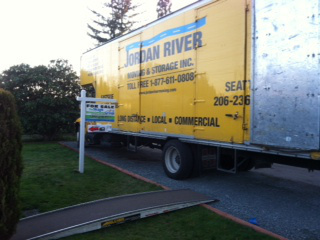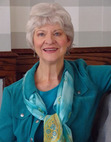Heidi M. Thomas's Blog, page 14
February 13, 2013
A Cowgirl Falls in Love
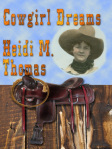 In my first novel, Cowgirl Dreams, Nettie and Jake are working horses together when they are caught in a sudden hail storm. In honor of Valentine’s Day, I’m offering this excerpt:
In my first novel, Cowgirl Dreams, Nettie and Jake are working horses together when they are caught in a sudden hail storm. In honor of Valentine’s Day, I’m offering this excerpt:
For just a moment the force of the hailstones seemed to let up, and Jake wrenched his saddle loose. “Here, grab one side.” He hoisted it over their heads. The sky grew a shade lighter as the hail turned into rain that fell in sheets, driven diagonally by the wind. Nettie stumbled along with Jake, bumping into each other. Both held the saddle up with one hand and led their horses with the other, the storm pushing them from behind.
Lightning slashed through the murky sky. A thunderclap rattled her teeth. The horses shied and tugged at the reins. Barely able to breathe, Nettie could no longer feel her hands. Her whole body was numb. She felt the saddle slip. They wouldn’t make it. She was going to fall. They’d both be hit by lightning.
“Hang on, we’re almost there.” Jake shifted the heavy saddle to take more of the weight himself. “It’s OK. You can do it. Come on. Just a few more steps.” Together they staggered the last few yards to the old shack. Jake dropped the saddle on the refuse-strewn porch and tethered the horses under the roof overhang on the lee side. Then he pushed the door open and helped Nettie through the opening. She nearly fell into the room, relief flooding over her.
He pushed the door shut against the gusts of wind and rain, and struggled to latch it. Then he knelt beside her, his wide eyes examining her face. “Are you all right? Are you hurt? Anything broken?”
“I’m OK.” Nettie looked up at him, gulped and blinked. “Oh my gosh, your eye …” She sat upright and reached up to caress the rapidly swelling bump.
“I’m just fine.”
“Oh, Jake, we coulda been killed.” She shuddered as the realization washed over her, then broke into great hiccupping sobs.
He encircled her with his long arms and drew her face to his chest. He smelled like horsehair and tobacco. It didn’t matter that his sodden denim shirt stuck to her cheek. She closed her eyes and snuggled close inside his embrace as he stroked her wet hair.
The rain beat a vicious tattoo on the roof. Just like those hailstones on her head and back. Her skin still stung, and her hands were raw and tingling. She shivered again. The ice seemed to have penetrated her blood. Her teeth chattered. Never in her life had she been so scared. They were lucky to be alive. Safe in his arms now, her sobs gradually subsided.
Jake hugged her closer, his face only inches from hers. She felt his warm breath on her cheek.
He rubbed a hand up and down her back, sending warm shivers through her body. “I have to let you go for a minute and see if I can get a fire going.”
Nettie clutched at him. She didn’t want him to go, even a few feet away.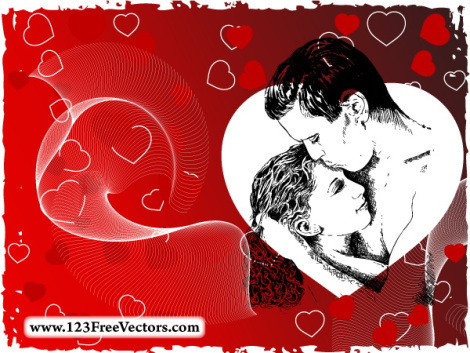
Murmuring in her ear as if soothing a skittish colt, he eased out of the embrace and off the floor. He picked up an old horse blanket from one corner of the nearly empty room and shook the dust off. Gently, he wrapped the worn, dirty wool pad around her shoulders.
Nettie glanced around the room, wallpaper peeling in strips, cobwebs strung over the windows, the floor rotted and splintered. Wonder what happened to the people who lived here? A wooden chair slumped on its side, a leg missing. Jake stomped on the remaining legs to break them, then the rungs and the back, into pieces. He pried up a loose floorboard to add to the pile of firewood
Nettie watched him squat before the fireplace, moving with such confidence. Gosh, he knows just what to do. He whittled shavings from the wood, then struck a match from a little tin canister in his pocket. He’s so handy. And so caring. He protected me.
Jake blew on the flame, coaxed it to catch. Above the sunburned line on his forehead where his hat usually rode, his skin was fair. His reddish blond hair shone softly.
The flame caught and grew, its flicker kindling a spark of hope in her. She heard the snap as it spread to the other shavings and sticks of wood.
Jake added more fuel to the fire. He coughed as it smoked, but then the smoke drew up into the chimney. He sat next to her again, cradling her in the curve of his arm. He took out a small flask from his pocket. “Here, have a slug of this. It’ll help warm you.”
She coughed at the harsh fire that ran down her throat. But it did warm her, and her shivers diminished as her clothes dried.
“Thank you for saving my life.” Nettie raised her face to his and kissed the corner of his mouth. Then, to hide her blush, she leaned against his strong body. He tightened his arm around her shoulders.
They’d made it. Together. They were together, and that was all that mattered right now.
Cowgirl Dreams and the sequel Follow the Dream are available through my website and as a Valentine’s week special, I’m offering FREE SHIPPING! Be watching for the third book in the series, Dare to Dream, coming in 2013.


February 7, 2013
Re-introducing Sweet Romance Series
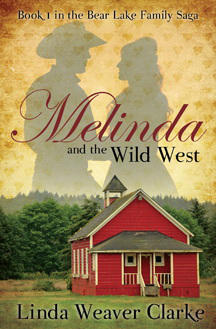 Welcome to my guest, Linda Weaver Clarke, who is celebrating the re-release of her sweet romances. She has Five Books To Give Away until Feb 14th: You have a chance to win one of five historical romances by Linda Weaver Clarke. Books: U.S. Ebooks: International.
Welcome to my guest, Linda Weaver Clarke, who is celebrating the re-release of her sweet romances. She has Five Books To Give Away until Feb 14th: You have a chance to win one of five historical romances by Linda Weaver Clarke. Books: U.S. Ebooks: International.
To enter the contest, visit http://lindaweaverclarke.blogspot.com/2013/02/five-historical-sweet-romances.html
You are the author of a historical sweet romance series called “A Family Saga in Bear Lake Idaho” that can be read by teens and adults alike. What was the inspiration behind the first novel?
In Melinda and the Wild West, I included one of my own experiences as a substitute teacher. An eight-year-old student had been labeled as a troublemaker by her teacher. The students had listened to the teacher and steered away from her, not wanting to be her friend. This not only made her feel degraded, but she wanted to fight back and she did. She stopped doing schoolwork, refused to be part of the class, and got into a few fights. She seemed angry at the world but after working with her for a while, I soon learned what a sweet and wonderful child she was. She had characteristics that I was impressed with. When she realized that I really cared, she was willing to do her work, just to please me. In fact, her mother was impressed that her daughter wanted to please me so much. I’ll never know how this young girl’s life turned out, but in my novel I chose a happily-ever-after ending, just because Melinda cared and made a difference in the girl’s life.
Why was this subject important to me? Because something similar happened to one of my own daughters when she was little and it was so difficult to see my child receive an unjust label from a teacher.
This novel has “sweet” romance and adventure. What kind of adventure? When Melinda takes a job as a schoolteacher in the small town of Paris, Idaho, she comes face-to-face with a notorious bank robber, a vicious grizzly bear, and a terrible blizzard that leaves her clinging to her life. But it’s a rugged rancher who challenges Melinda with the one thing for which she was least prepared—love.
Do you ever add true family experiences in your historical novels?
After writing my ancestors’ and parents’ stories, I felt so close to them and wanted to add their experiences to my “sweet” romance series. In Melinda and the Wild West, I added one of my father’s experiences as a boy. When he was thirteen, he was asked to bury the skunks that his father had shot. But before he buried them, he drained the scent glands of each skunk until he had a jar full of “skunk oil.” Then he took it to school with him to show his classmates. He was so excited as he explained how he had done it. But in all the excitement, the bottle slipped from his hands and landed on the schoolroom floor and splattered everywhere. The stench was so terrible that everyone held their noses and ran outside as fast as their legs could go. The teacher excused school for the rest of the day and my dad was considered a “hero” by his classmates because he had closed down the school.
What kind of research do you do for one of your novels?
I put a great deal of research into my novels. The subplot of Jenny’s Dream, the 3rd book in this series, is about Old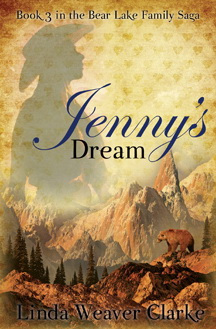 Ephraim, the ten-foot grizzly bear. The research about this old grizzly was exciting to me because Old Ephraim was from southern Idaho, where I was raised. He wreaked havoc wherever he went, killing sheep and scaring sheepherders so badly that they actually quit their jobs. He was so powerful that with one blow of his paw, he could break the back of a cow. I found out he was the smartest bear that ever roamed the Rocky Mountains. No one could catch him. Every bear trap Frank Clark set was tossed many yards away from where he had put it, and the ones that weren’t tripped had his tracks all around it. How did he know? Because Old Ephraim only had three toes. So they called him Old Three Toes. He was too smart to be caught so Frank Clark had to outsmart him. In this story, I included every detail about this bear and his deeds.
Ephraim, the ten-foot grizzly bear. The research about this old grizzly was exciting to me because Old Ephraim was from southern Idaho, where I was raised. He wreaked havoc wherever he went, killing sheep and scaring sheepherders so badly that they actually quit their jobs. He was so powerful that with one blow of his paw, he could break the back of a cow. I found out he was the smartest bear that ever roamed the Rocky Mountains. No one could catch him. Every bear trap Frank Clark set was tossed many yards away from where he had put it, and the ones that weren’t tripped had his tracks all around it. How did he know? Because Old Ephraim only had three toes. So they called him Old Three Toes. He was too smart to be caught so Frank Clark had to outsmart him. In this story, I included every detail about this bear and his deeds.
The Bear Lake Monster was a fun one to research. Scotland has the Lock Ness Monster and Bear Lake Valley has theirs. In my 4th novel in this series, Sarah’s Special Gift, the subplot is about David trying to disprove the legend of the Bear Lake Monster. I was raised just over the mountain from Bear Lake so the research about the monster was fun. I discovered that it was 90-feet long, his eyes were flaming red, and his ears stuck out from the sides of his skinny head. Its body was long, resembling a gigantic alligator and it could swim faster than a galloping horse. It had small legs and a huge mouth, big enough to eat a man. (Ha-ha.) I was surprised about what I found. I even got an email from a woman who said that her grandfather had seen the monster. In fact, many people still believe in the Bear Lake Monster today.
What was the inspiration behind the last four novels in this series?
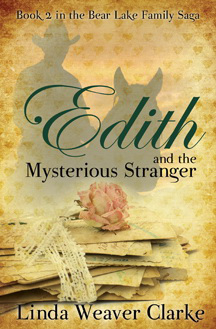 Edith and the Mysterious Stranger was inspired by my parents’ courtship. They didn’t meet the traditional way. They met through letters. Their story was so romantic that I patterned this book after their courtship and used my father’s sweet, romantic letters. Can people really fall in love through letters? Absolutely! With mysterious letters, cattle rustlers, a spunky woman, Halloween, and young love, there is always something happening.
Edith and the Mysterious Stranger was inspired by my parents’ courtship. They didn’t meet the traditional way. They met through letters. Their story was so romantic that I patterned this book after their courtship and used my father’s sweet, romantic letters. Can people really fall in love through letters? Absolutely! With mysterious letters, cattle rustlers, a spunky woman, Halloween, and young love, there is always something happening.
Jenny’s Dream was inspired because of some unpleasant childhood experiences that I experienced as a young girl and now Jenny must learn forgiveness before she can choose which dream to follow. Meanwhile, a legendary ten-foot grizzly is seen in the area and its boldness has frightened the community.
Sarah’s Special Gift was inspired because of my great grandmother who was deaf. I wanted to learn more about her life and how she coped with her disability. I learned so much about her and how courageous she was, so I decided to give her experiences to my character, Sarah. This story has deep-rooted legends, a few mysterious events, the mystery of the Bear Lake Monster, and a tender love story!
Elena, Woman of Courage is my last book in this series. My inspiration was the “Roaring Twenties.” This was a new 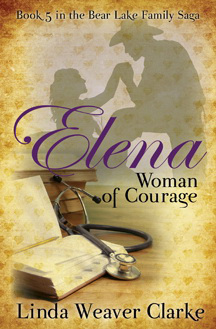 decade of independent women, when they raised their hemlines and bobbed their hair. I found that if a woman bobbed her hair, she was fired from her job. A new language grew from this time period. They used words like: Cat’s pajamas! Horsefeathers! Baloney! When referring to a woman, they used doll or tomato. What was the difference? A tomato was a woman. A doll was a good-looking woman. A woman’s legs were called “gams” and her lovely shape was referred to as a “chassis.” If you were in love, you had a “crush,” were “goofy,” or “moonstruck.” And when a woman was not in the mood for kissing, she would say, “The bank’s closed.” Thus, my new novel was born! As Elena Yeates fights to prove herself as the newest doctor in town, the town’s most eligible bachelor finds it a challenge to see if he can win her heart.
decade of independent women, when they raised their hemlines and bobbed their hair. I found that if a woman bobbed her hair, she was fired from her job. A new language grew from this time period. They used words like: Cat’s pajamas! Horsefeathers! Baloney! When referring to a woman, they used doll or tomato. What was the difference? A tomato was a woman. A doll was a good-looking woman. A woman’s legs were called “gams” and her lovely shape was referred to as a “chassis.” If you were in love, you had a “crush,” were “goofy,” or “moonstruck.” And when a woman was not in the mood for kissing, she would say, “The bank’s closed.” Thus, my new novel was born! As Elena Yeates fights to prove herself as the newest doctor in town, the town’s most eligible bachelor finds it a challenge to see if he can win her heart.
Visit Linda’s Website or her Blog and read a review at Page One.com


Welcome to my guest, Linda Weaver Clarke, who is celebrat...
 Welcome to my guest, Linda Weaver Clarke, who is celebrating the re-release of her sweet romances.
Welcome to my guest, Linda Weaver Clarke, who is celebrating the re-release of her sweet romances.
You are the author of a historical sweet romance series called “A Family Saga in Bear Lake Idaho” that can be read by teens and adults alike. What was the inspiration behind the first novel?
In Melinda and the Wild West, I included one of my own experiences as a substitute teacher. An eight-year-old student had been labeled as a troublemaker by her teacher. The students had listened to the teacher and steered away from her, not wanting to be her friend. This not only made her feel degraded, but she wanted to fight back and she did. She stopped doing schoolwork, refused to be part of the class, and got into a few fights. She seemed angry at the world but after working with her for a while, I soon learned what a sweet and wonderful child she was. She had characteristics that I was impressed with. When she realized that I really cared, she was willing to do her work, just to please me. In fact, her mother was impressed that her daughter wanted to please me so much. I’ll never know how this young girl’s life turned out, but in my novel I chose a happily-ever-after ending, just because Melinda cared and made a difference in the girl’s life.
Why was this subject important to me? Because something similar happened to one of my own daughters when she was little and it was so difficult to see my child receive an unjust label from a teacher.
This novel has “sweet” romance and adventure. What kind of adventure? When Melinda takes a job as a schoolteacher in the small town of Paris, Idaho, she comes face-to-face with a notorious bank robber, a vicious grizzly bear, and a terrible blizzard that leaves her clinging to her life. But it’s a rugged rancher who challenges Melinda with the one thing for which she was least prepared—love.
Do you ever add true family experiences in your historical novels?
After writing my ancestors’ and parents’ stories, I felt so close to them and wanted to add their experiences to my “sweet” romance series. In Melinda and the Wild West, I added one of my father’s experiences as a boy. When he was thirteen, he was asked to bury the skunks that his father had shot. But before he buried them, he drained the scent glands of each skunk until he had a jar full of “skunk oil.” Then he took it to school with him to show his classmates. He was so excited as he explained how he had done it. But in all the excitement, the bottle slipped from his hands and landed on the schoolroom floor and splattered everywhere. The stench was so terrible that everyone held their noses and ran outside as fast as their legs could go. The teacher excused school for the rest of the day and my dad was considered a “hero” by his classmates because he had closed down the school.
What kind of research do you do for one of your novels?
I put a great deal of research into my novels. The subplot of Jenny’s Dream, the 3rd book in this series, is about Old Ephraim, the ten-foot grizzly bear. The research about this old grizzly was exciting to me because Old Ephraim was from southern Idaho, where I was raised. He wreaked havoc wherever he went, killing sheep and scaring sheepherders so badly that they actually quit their jobs. He was so powerful that with one blow of his paw, he could break the back of a cow. I found out he was the smartest bear that ever roamed the Rocky Mountains. No one could catch him. Every bear trap Frank Clark set was tossed many yards away from where he had put it, and the ones that weren’t tripped had his tracks all around it. How did he know? Because Old Ephraim only had three toes. So they called him Old Three Toes. He was too smart to be caught so Frank Clark had to outsmart him. In this story, I included every detail about this bear and his deeds.
Ephraim, the ten-foot grizzly bear. The research about this old grizzly was exciting to me because Old Ephraim was from southern Idaho, where I was raised. He wreaked havoc wherever he went, killing sheep and scaring sheepherders so badly that they actually quit their jobs. He was so powerful that with one blow of his paw, he could break the back of a cow. I found out he was the smartest bear that ever roamed the Rocky Mountains. No one could catch him. Every bear trap Frank Clark set was tossed many yards away from where he had put it, and the ones that weren’t tripped had his tracks all around it. How did he know? Because Old Ephraim only had three toes. So they called him Old Three Toes. He was too smart to be caught so Frank Clark had to outsmart him. In this story, I included every detail about this bear and his deeds.
The Bear Lake Monster was a fun one to research. Scotland has the Lock Ness Monster and Bear Lake Valley has theirs. In my 4th novel in this series, Sarah’s Special Gift, the subplot is about David trying to disprove the legend of the Bear Lake Monster. I was raised just over the mountain from Bear Lake so the research about the monster was fun. I discovered that it was 90-feet long, his eyes were flaming red, and his ears stuck out from the sides of his skinny head. Its body was long, resembling a gigantic alligator and it could swim faster than a galloping horse. It had small legs and a huge mouth, big enough to eat a man. (Ha-ha.) I was surprised about what I found. I even got an email from a woman who said that her grandfather had seen the monster. In fact, many people still believe in the Bear Lake Monster today.
What was the inspiration behind the last four novels in this series?
 Edith and the Mysterious Stranger was inspired by my parents’ courtship. They didn’t meet the traditional way. They met through letters. Their story was so romantic that I patterned this book after their courtship and used my father’s sweet, romantic letters. Can people really fall in love through letters? Absolutely! With mysterious letters, cattle rustlers, a spunky woman, Halloween, and young love, there is always something happening.
Edith and the Mysterious Stranger was inspired by my parents’ courtship. They didn’t meet the traditional way. They met through letters. Their story was so romantic that I patterned this book after their courtship and used my father’s sweet, romantic letters. Can people really fall in love through letters? Absolutely! With mysterious letters, cattle rustlers, a spunky woman, Halloween, and young love, there is always something happening.
Jenny’s Dream was inspired because of some unpleasant childhood experiences that I experienced as a young girl and now Jenny must learn forgiveness before she can choose which dream to follow. Meanwhile, a legendary ten-foot grizzly is seen in the area and its boldness has frightened the community.
Sarah’s Special Gift was inspired because of my great grandmother who was deaf. I wanted to learn more about her life and how she coped with her disability. I learned so much about her and how courageous she was, so I decided to give her experiences to my character, Sarah. This story has deep-rooted legends, a few mysterious events, the mystery of the Bear Lake Monster, and a tender love story!
Elena, Woman of Courage is my last book in this series. My inspiration was the “Roaring Twenties.” This was a new  decade of independent women, when they raised their hemlines and bobbed their hair. I found that if a woman bobbed her hair, she was fired from her job. A new language grew from this time period. They used words like: Cat’s pajamas! Horsefeathers! Baloney! When referring to a woman, they used doll or tomato. What was the difference? A tomato was a woman. A doll was a good-looking woman. A woman’s legs were called “gams” and her lovely shape was referred to as a “chassis.” If you were in love, you had a “crush,” were “goofy,” or “moonstruck.” And when a woman was not in the mood for kissing, she would say, “The bank’s closed.” Thus, my new novel was born! As Elena Yeates fights to prove herself as the newest doctor in town, the town’s most eligible bachelor finds it a challenge to see if he can win her heart.
decade of independent women, when they raised their hemlines and bobbed their hair. I found that if a woman bobbed her hair, she was fired from her job. A new language grew from this time period. They used words like: Cat’s pajamas! Horsefeathers! Baloney! When referring to a woman, they used doll or tomato. What was the difference? A tomato was a woman. A doll was a good-looking woman. A woman’s legs were called “gams” and her lovely shape was referred to as a “chassis.” If you were in love, you had a “crush,” were “goofy,” or “moonstruck.” And when a woman was not in the mood for kissing, she would say, “The bank’s closed.” Thus, my new novel was born! As Elena Yeates fights to prove herself as the newest doctor in town, the town’s most eligible bachelor finds it a challenge to see if he can win her heart.
Visit Linda’s Website or her Blog and read a review at Page One.com


February 1, 2013
Travel Destination: Prescott AZ
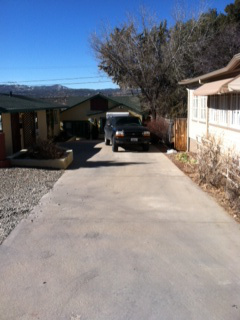 My husband had the fun job of backing the trailer down this l-o-n-g driveway after dark the first night we arrived. Glad it wasn’t me!
My husband had the fun job of backing the trailer down this l-o-n-g driveway after dark the first night we arrived. Glad it wasn’t me!
We’ve been in Prescott for 10 days now and have experienced the gamut of weather. The first day, we had 63 degree temperatures and unloaded our vehicles and U-haul trailer in shorts and T-shirts.
The next couple of days were partly sunny, but then it commenced to rain for three days straight! We thought we were back in the Pacific NorthWET! The temps plummeted and suddenly we were in the middle of a snowstorm!
But at this writing, it’s back up to 48 degrees and the beautiful sunshine is making me smile!
The little cottage we’re renting on Mount Vernon Ave. in Prescott. Must be an omen!
Another gorgeous sunset on the road between Prescott and Chino Valley.
The tree-lined Mount Vernon Avenue in Prescott, our temporary home.
 One of the beautiful old homes on Mount Vernon Ave. Reminds me a lot of the University district in Missoula, Montana.
One of the beautiful old homes on Mount Vernon Ave. Reminds me a lot of the University district in Missoula, Montana.
Prescott (pronounced Preskett, emphasis on the first syllable) has an official population of 39,900 (although a Money Magazine report says 42,000), and Chino Valley (15 miles North), where we will be living in April, is listed at 10,800. The area has been named one of the top 25 places to retire, sits at 5,300 feet, with four-seasons: mild to somewhat cold winters and warm to hot summers. Highs range from 50 °F in January to 89 °F in July, and the average annual precipitation is 19.2 inches.
Prescott is the county seat of Yavapai County. In 1864 Prescott was designated as the capital of the Arizona Territory. Phoenix became the capital in 1889. Prescott also has a place in western folklore with the fact that Virgil Earp, Wyatt Earp’s older brother lived in Prescott in 1879 and told him of the boom town in Tombstone, Arizona. It is also rumored that Doc Holliday spent some time in Prescott just before heading to Tombstone.
The “Quad City” area encompasses Prescott, Chino Valley, Prescott Valley and Dewey-Humbolt in Yavapai County. It’s a beautiful, sunny place to explore, and we’re happy to be here!


January 27, 2013
On the Road to Prescott
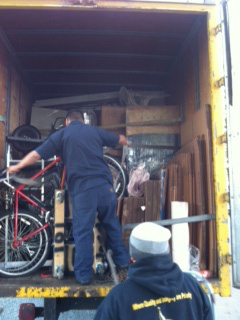 January 16, 2013: the moving truck pulls away from Mount Vernon, WA with all our worldly possessions (most of them anyway!) and we pack what we need for two and a half months interim living before we actually move into our new home in Chino Valley, AZ.
January 16, 2013: the moving truck pulls away from Mount Vernon, WA with all our worldly possessions (most of them anyway!) and we pack what we need for two and a half months interim living before we actually move into our new home in Chino Valley, AZ.
We spend a couple of days in town to tie up loose ends and say good-bye to friends, then on Saturday the 19th we take off in the early morning fog, which lasted until North Bend. We saw sun for awhile but then were back in heavy fog through Pendleton, OR, a disappointment because I really would like to have seen the famous rodeo town a little better.
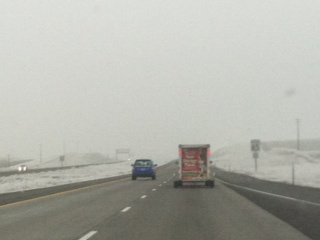 This was my view for 1,400 miles (the back end of a U-haul trailer).
This was my view for 1,400 miles (the back end of a U-haul trailer).
Just as I was laughing at the “Scenic Viewpoint” signs as we climbed Deadman Pass over the Blue Mountains south of Pendleton on I-84, we suddenly broke out into the sun! Yippee! I felt a huge weight lifted and what a gorgeous view!
We stopped to rest for the night in Boise, ID, finding a frosty 1 degree temperature! We’re not used to that any more! I wondered what I had done with my longjohns!
After leaving Idaho, we continued south on Highway 93, the infamous road that stretches from Canada through Montana where we used to live, nearly to Mexico (it’s southern terminus is at Wickenburg AZ). Many Montanans used to sport bumper stickers reading “I drive Highway 93; Pray for Me!”
More snow in Nevada, but as we descend from White Horse Pass (elevation 6,031 feet), the temps get warmer. Much of this countryside reminds me of eastern Montana, where I grew up (minus the mountains).
Going through the White River Narrows–beautiful and fascinating rock formation and petroglyphs. White River Narrows is located approximately 150 miles north of Las Vegas and 90 miles south of Ely Nevada. It was placed on the National Register of Historic Places in 1976.
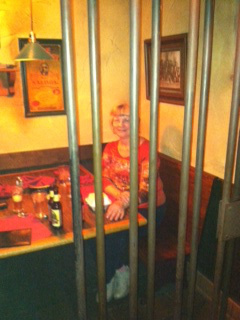 We spent the next night in Ely, NV and ate at a restaurant called The Jailhouse. Each table was in its own “cell” and the menu items were all named appropriately “Robbers Ribs” and the like.
We spent the next night in Ely, NV and ate at a restaurant called The Jailhouse. Each table was in its own “cell” and the menu items were all named appropriately “Robbers Ribs” and the like.
After leaving Hwy93, we were once again on the Interstate, I-15 which took us to Las Vegas. We stopped there long enough to grab a burger on the run and gas up our vehicles. We were in a hurry to get to our new home! Due to the load in the pickup and the U-haul trailer, my husband was not able to travel as fast as we normally would, especially going uphill. I was following along in my little blue Chevy, with my cat sedated by my side.
Our first Arizona sunset the evening of Jan. 21 as we approach closer to Prescott.


January 17, 2013
A New Adventure for Heidi M. Thomas
Well, folks, today was the last time I will enter my house in Mount Vernon Washington. A bittersweet day, but my husband and I are embarking on a new life adventure by moving to the Prescott AZ area. My DH retired at the end of 2012 and we’ve been talking about moving somewhere with more sunshine (although it’s been crisp and cold and sunny here the last several days!)
Yesterday all our earthly possessions were loaded onto this truck and we are spending a couple extra days, saying good-bye to all our friends. Mount Vernon has been good for us and we will miss many things about it–most of all our friends, our church, the lush green. But we are looking forward to new friends, sunshine, good health and retirement.
And we’re all still connected via this wonderful thing called the Internet! “On the Road Again!”
Au revoir, Auf Weidersehen, till we meet again!


January 10, 2013
YA Author Tackles Prohibition Mystery for Her First Novel
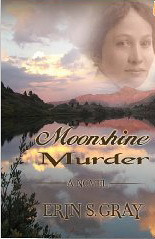 My guest this week is Erin S. Gray, author of Moonshine Murder, a young adult novella.
My guest this week is Erin S. Gray, author of Moonshine Murder, a young adult novella.
Synopsis: It’s 1925. The small cabin deep in the San Juan Mountains is the only home seventeen-year-old Lenora Giovanni has ever known. But when her father dies from tainted moonshine, leaving her alone, she is forced into a life of danger.
Lenora is determined to find whoever sold the poison to her father–a determination that leads her into working as an undercover agent in the town of Durango, Colorado. She meets Rusty, a young moonshiner who guides her through the world of bootlegging.
As Lenora gets to know this intriguing young man, three things become clear: Her father was entangled in a scheme of deception. Rusty is keeping secrets–secrets about her past. And she is falling irrationally and unconditionally in love with him.
Faced with betrayal, Lenora is tempted to protect Rusty and preserve her father’s memory, rather than bust the illegal moonshine business that destroyed her family. How will she choose: with her head or her heart?
This is your debut novel. Tell us about how the idea and the story came about.
I first met my main character, Lenora, on a backpacking trip deep in the San Juan Mountains. As I sat watching the sunset, light reflected on a small cabin across the canyon. I dreamed of a girl surviving in harsh conditions. What would her world be like? Over the years, I became more acquainted with this character, Lenora, until I felt she was alive and breathing. Almost a decade later, I made the trip to the cabin that started Lenora’s journey. A well hidden treasure, it still stands today. Between my imagination and the research I conducted, the story fell into place.
How long did it take you to research, write and get it published?
I started writing Moonshine Murder in 2003 and finished the first draft in the fall of 2004. I was teaching full-time and wrote after work and on the weekends. I added more historical details during later drafts, and spent a large portion of time researching. Then I began submitting to publishers in the spring of 2006 after the birth of my first son. I received eight rejections from publishers, and would consider their advice and if warranted, change my manuscript, then submit again. My acceptance for publication came in the spring of 2012.
What made you decide to write a mystery?
The story evolved into a mystery from the research I had done. I became fascinated with all the secrets I uncovered about Prohibition in the Durango, Colorado area. As my characters developed, I knew that a mystery was the best mode for my story.
Can you tell us what is unique about your book?
There is very little written history about Prohibition in Colorado, and even less for young adults. My book captures the culture of mining immigrant communities as well as explores some of the “dirtier” secrets of Prohibition in a book appropriate for young readers.
What other writing have you done before this?
I wrote a complete manuscript about a decade prior to Moonshine Murder, which explored the Irish immigrants during The Great Potato Famine. I never pursued a publisher for this piece, but received encouragement from the English Department at Colorado State University to continue writing. I’ve also written a handful of short fiction pieces, and some poetry.
What was the very first book you remember reading and loving? What makes that book so special?
Down the Long Hill by Louis L’Amour. My dad would read this novel over and over to me, at my insistence. I fell in love with historical fiction, particularly western historical fiction at the impressionable age of eight. I was collecting my own L’Amour novels shortly after that, and could not put them down.
What other books or authors have influenced your writing?
Without a doubt, Louis L’Amour has been a large influence in my writing. I met his wife once, after he had passed away, who told me that persistence was the key to his success. I was in high school at the time and decided I could do this writing thing then, because I’m stubborn!
Other influential authors are Janette Oke, Lori Wick, in the Historical Christian Romance category. Classic Christian writer, Grace Livingston Hill has been a recent and most loved discovery. I can’t discount some of the current young adult writers out there like Suzanne Collins for writing about difficult situations
You are a mother of two, a part-time bookkeeper, President of Women Writing the West, and a writer. What is your writing routine, and how do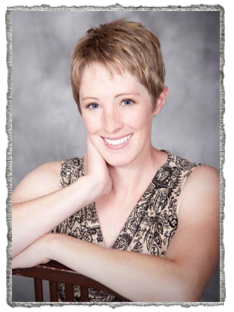 you unwind from all of this?
you unwind from all of this?
I work outside of the home a couple days of the week. I have a home office in the basement (I call it the studio – much less depressing) so when it comes to writing, I write when my oldest son is at school and the baby is napping. When nap time is over, I answer WWW emails and market Moonshine Murder while playing with the baby. I “unwind” on my treadmill, although here I’m working too. Believe it or not, I use this time to catch up on my reading – done much easier with a Kindle then back when I used to use “chip clip” to hold the book open! Evenings are family time, though.
Where can we purchase your book and get more information about you?
Moonshine Murder can be obtained at my website at http://www.erinsgray.com, http://www.trebleheartbooks.com, Baker and Taylor Books, or at www.Amazon.com, . I have developed a complete teaching guide for Moonshine Murder as a free download on my website. Teacher copies are FREE, so if you know a teacher who may want to teach Moonshine Murder, please send them to my website.
Bio:
Erin S. Gray writes historical fiction for adults and young adults. She backpacks through the very mountains about which she writes and was inspired to begin her novel, Moonshine Murder, after stumbling across an abandoned cabin during a trek deep in the San Juan Mountains.
Erin is the 2013 president of Women Writing the West, and an active member of the Society of Children’s Book Writers and Illustrators. A graduate of Colorado State University with a degree in English, she lives in southwest Colorado with her husband and two young sons. For more information about the author, visit her website.


January 3, 2013
Writing ‘Raising Wrecker’, a Labor of Love
Summer Wood is my guest this week. Summer is the author of Raising Wrecker, a contemporary novel that won a WILLA Literary Award this year, and writes about how this book came about.
by Summer Wood
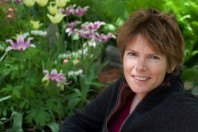 As a reader and a writer, I love stories that challenge my ordinary perception. As a mother, on the other hand, I find I’m perfectly okay with the status quo. I don’t need surprise or revelation in that job description. I like it when things go smoothly. I don’t like to have my feathers ruffled.
As a reader and a writer, I love stories that challenge my ordinary perception. As a mother, on the other hand, I find I’m perfectly okay with the status quo. I don’t need surprise or revelation in that job description. I like it when things go smoothly. I don’t like to have my feathers ruffled.
Except, of course (Mothers? Can you confirm this for me?) – they never do go completely smoothly, do they?
Raising Wrecker came about because of an unexpected bump in my personal motherhood curve. And even though my writing rarely follows the contours of my life, the experience of being a foster parent was so emotionally acute that I turned to fiction to see my way through to a clearer understanding.
We entered the experience innocently enough. We had trained to become emergency foster care parents, thinking that if a local kid needed someplace to stay briefly while the family was in trouble, we could harbor him or her for a weekend or so. With our three sons and their friends, our place was overrun with kids, anyway. The screen door kept slamming as one neighbor child or another came or went. What was one more for a couple of days?
One, maybe; but the first call we got was for four small brothers who needed a family to stay with. Their parents were both battling drug problems, in trouble with the law, and the authorities had removed the kids upon confirmation of neglect. Sally, the social worker, said that if we couldn’t take these boys – aged 4, 3, 2, and not-quite-1 – they’d be split up and sent to different homes.
You want us to take them for the weekend?
Indefinitely, she said, and coughed politely into her hand.
We thought hard. We consulted our sons. And then we said yes, and for nearly two winter months, these small boys – who came to us with pneumonia, an amazing roster of aberrant behaviors, a black trash bag of shorts, t-shirts, and ill-fitting sneakers, and the most cherubic little faces – lived in our home and rapidly took up residence in our hearts.
It’s a long story, the saga of their journey back and forth, into and out of their parents’ custody. We became friends of the family, kind of informal kin to the boys. We were on hand to help when a fifth child was born with medical complications. We rooted for the parents, celebrated with them, wept with them, and when, at last, the whole house of cards came tumbling down, we felt our hearts break for them as their parental rights were terminated and the boys were adopted out to separate families.
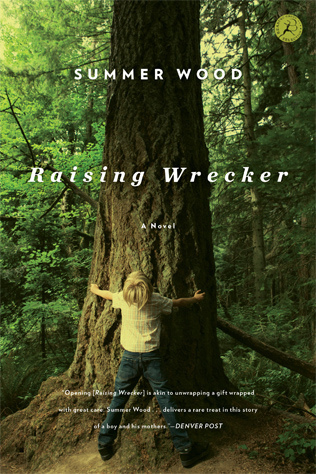 I didn’t write this novel in conscious response to having fostered those children. As any novel will, it grew out of a rank stew of personal experience, literary experiment, political inquiry, and meandering imagination – with a good dose of love, whimsy, fear, humor, and warped psychological obsession thrown in. This imaginary child, Wrecker, arrived in a public
I didn’t write this novel in conscious response to having fostered those children. As any novel will, it grew out of a rank stew of personal experience, literary experiment, political inquiry, and meandering imagination – with a good dose of love, whimsy, fear, humor, and warped psychological obsession thrown in. This imaginary child, Wrecker, arrived in a public
playground one June afternoon in 1965, and I wanted to know what would happen to him. I wanted to know his mother, and how she lost him, and who would come to love and raise him, and what kind of man he would turn out to be.
Writing his mothers into being – both the one who gave him his start, and the one into whose arms he fell – meant coming to terms with the power of parents. It meant coming up hard against the truth that no parent, not one of us, is perfect. It meant facing head-on the fact that the mistakes we make can have grave consequences. It meant learning forgiveness as a kind of survival strategy.
I’ve come to believe that it is a radical expression of love to parent any child. And that there’s no right way to do it. It can only be done by trial and error, and error, and error, and trying again. And, yes; there will be unexpected bumps. There will be ruffled feathers.
And writing Wrecker himself? Writing Wrecker into being was a way for me to believe again in the possibilities open to children. I needed to reconnect with the hope that led us to step forward and say: yes. With whatever we can offer, for as long as we can, we’ll welcome these children into our lives.
It was an honor to have the chance to know those boys and their parents. And the best way I knew to pay back that honor was to bring this other boy, Wrecker, into the world, and let him muscle his way, with grace and love and a good share of noise, into his future.


December 26, 2012
Kaila Mussell, First Woman to Compete in Men’s Rodeo Since 1941
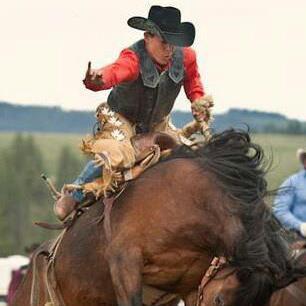 Welcome to my guest, Kaila Mussell, a saddle-bronc-riding cowgirl from Chilliwack BC. Kaila is the first and only woman since the 1940s to qualify to compete with men in the Professional Rodeo Cowboys Association.
Welcome to my guest, Kaila Mussell, a saddle-bronc-riding cowgirl from Chilliwack BC. Kaila is the first and only woman since the 1940s to qualify to compete with men in the Professional Rodeo Cowboys Association.
Kaila, tell me how you got involved in riding rough stock?
Grew up on a farm, mainly horses, some cows, dogs etc. Started off as a barrel racer, steer rider, professional trick rider and then saddle bronc riding. My dad was a saddle bronc rider and bull rider and my mom was a rodeo queen. My oldest brother CEJ rode saddle broncs and steer wrestled and my younger sister Filene barrel raced and rode steers as well.
How did you earn enough points to compete with the men in the PRCA?
To fill your pro card (to become a full-card professional) you have to win $1,000 while competing in PRCA approved rodeos. Generally you can enter the smaller money-added rodeos, but you can’t qualify for large big-money added rodeos, or if you can, they draw amongst those who have their PERMIT…you can buy a permit to enter rodeos, once you win the money you have the option of buying your full pro card.
Are there any other women who are getting close?
There is a female bull rider who has won some money but hasn’t filled her pro card
Why do you do it?
Challenge, adrenaline rush, danger, love of the sport – the feeling of being in sync with a bucking horse.
Can you describe the feeling of being on the back of a thrashing, sunfishing bronc who only wants to shed its unwelcome burden?
Thrilling, powerful, connected, reactive, instinctive.
What’s your definition of danger?
Whatever gets your heart racing and seems scary.
What do you feel like when you know you’ve made a successful ride?
Happy, excited, successful, energetic, positive, confident, empowered.
Have you run into any stigma or prejudice against a woman doing a “man’s” extreme sport?
Some, as to be expected but it’s all in your attitude. Doing what I do, if you go after it for the same reasons, put in an honest effort and are serious about what you do, I find for the most part males are relatively accepting, especially the younger generations.
How did your family feel when you decided this was your career?
I wouldn’t consider saddle bronc riding a career. It definitely doesn’t pay my bills. I’d call it a passion, an expensive hobby. My family overall has been pretty supportive but they also have been involved in rodeo so that definitely helps. They support me in what I do.
How many broken bones, injuries etc. have you had?
Lots, broke left collar bone, right collar bone twice, separated right shoulder, dislocated left shoulder twice, two surgeries on left shoulder, one surgery on right, 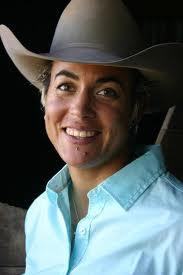 both knees, ACL surgeries, broken right wrist.
both knees, ACL surgeries, broken right wrist.
What keeps you going?
Drawn to the support, invested a lot of time, energy, passionate about the sport, love what I do.
Do you enjoy the travel or does it get old after awhile?
Yes and no, traveling to new places is exciting, traveling by yourself can get old, but with company it is fun. If you are doing well rodeoing the traveling is easy, if not, it is hard
What gets you down?
Not riding up to my expectations, drawing poor broncs, being broke.
What brings you back up?
Family, friends and fans’ support, looking at the bigger picture – my goals, why I do what I do, inspirational quotes.
Do you have an old-time cowgirl heroine?
None in particular but I did look up to and was inspired by a lot of the early cowgirls from the early 1900s.
If you weren’t a bronc-riding cowgirl, what would you like to be?
A professional snowboarder or surfer or downhill bike racer or motorcross…anything to keep up with the adrenaline rush
Do you have a particular philosophy of life?
Live for the now, don’t dwell on the little things, focus on what makes you happy, follow your heart, don’t take life too seriously
A favorite quote or theme you live by?
“I will not tiptoe through life only to arrive safely at death.”
Tell me about the recent competition you went to in Vegas—the Indian National Finals Rodeo (INFR).
I was the first female to ever qualify for the INFR this year in Las Vegas in saddle bronc. It was a very cool feat and I’m proud that I did. I didn’t do as well as I had hoped in Vegas, but it was a great experience and met a lot of really cool people and had a good time. There is always next year.
Thank you, Kaila! I have been researching women’s rodeo from the early 1900s, since my grandmother rode bucking stock in Montana rodeos in the 1920s. Back then, women competed in the same arena as men, drawing the same bucking stock they did, and at times even beating the men in steer roping and many other events. Madison Square Garden in 1941 was the last World Champion rodeo where women were allowed to compete on rough stock. Vivian White of Oklahoma won that championship. Kaila Mussell is the first women since that time to qualify and compete with men in the PRCA arena.
Follow Kaila on her blog, on Twitter, on Facebook and see a post by the Lone Cowgirl.



